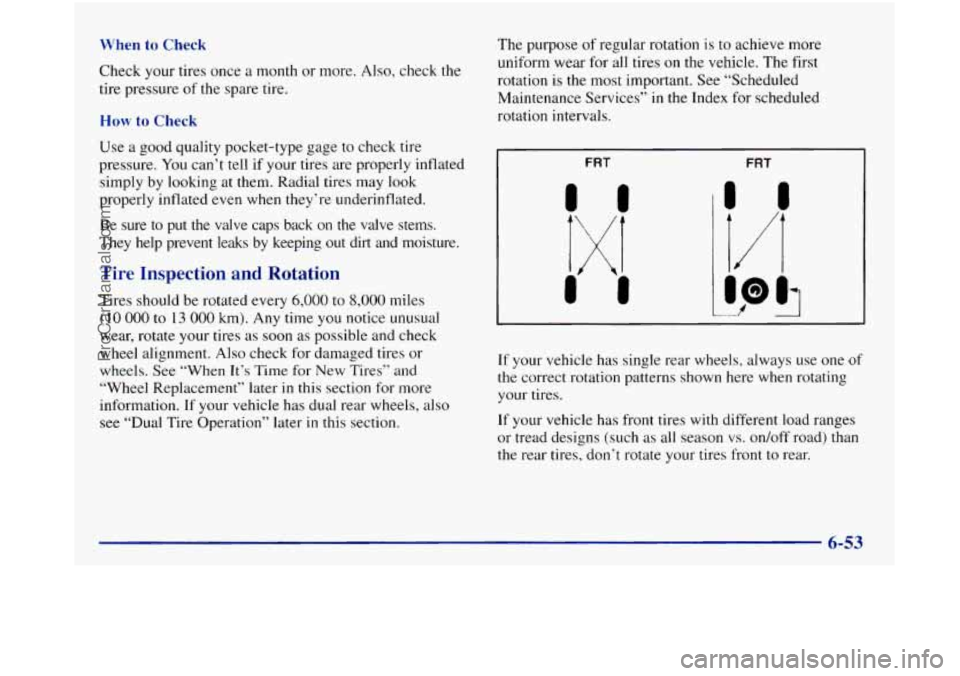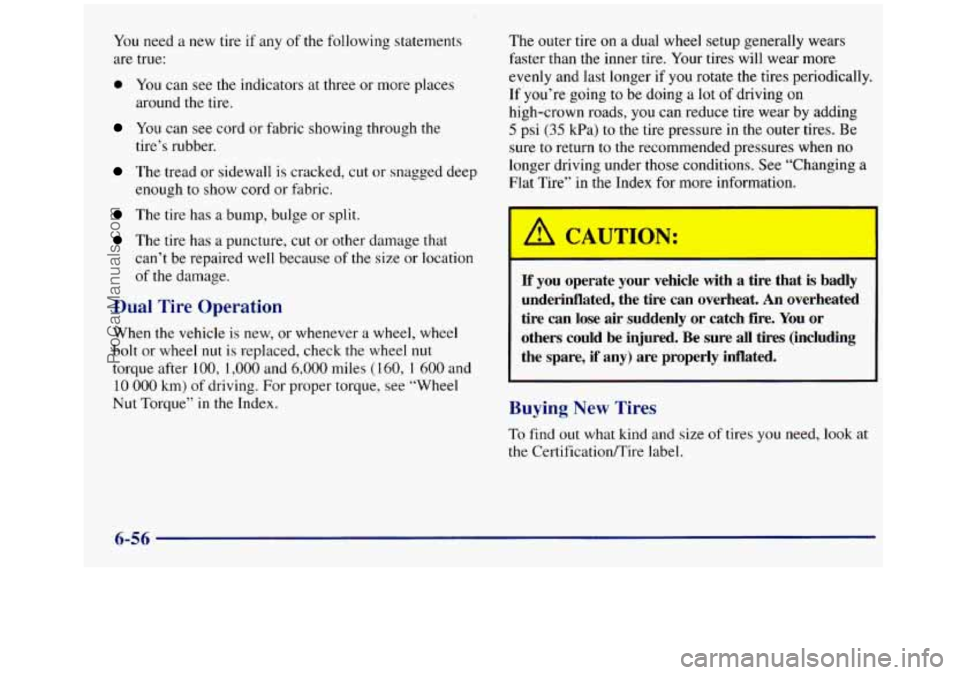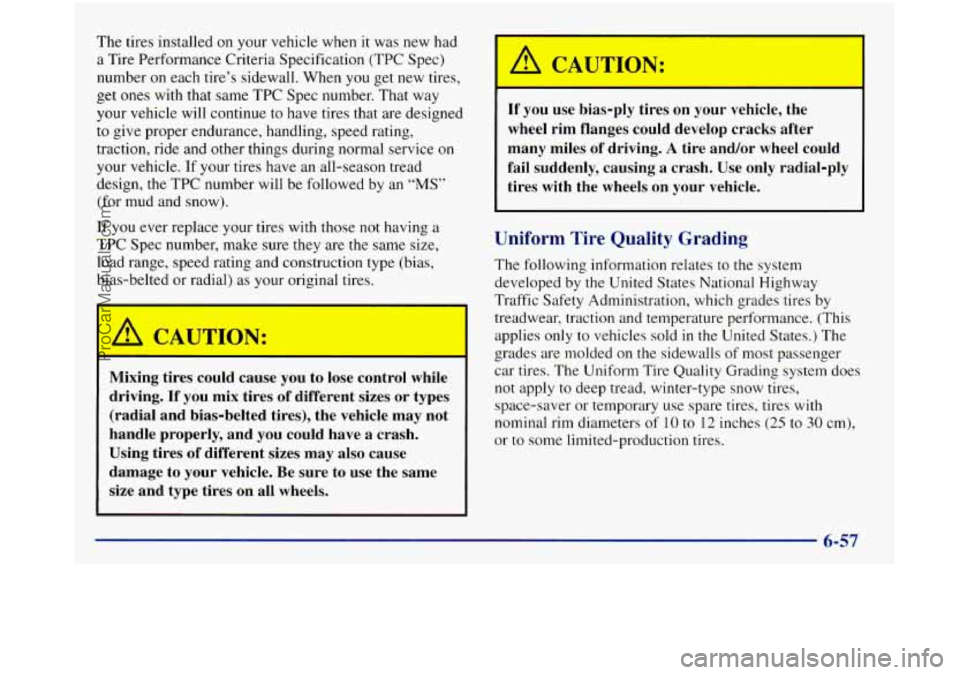Page 343 of 452

When to Check
Check your tires once a month or more. Also, check the
tire pressure of the spare tire.
How to Check
Use a good quality pocket-type gage to check tire
pressure. You can’t tell if your tires are properly inflated
simply by looking at them. Radial tires may
look
properly inflated even when they’re underinflated.
Be sure
to put the valve caps back on the valve stems.
They help prevent leaks by keeping out dirt and moisture.
Tire Inspection and Rotation
Tires should be rotated every 6,000 to 8,000 miles
(10 000 to 13 000 km). Any time you notice unusual
wear, rotate your tires as soon as possible and check
wheel alignment.
Also check for damaged tires or
wheels.
See “When It‘s Time for New Tires” and
“Wheel Replacement” later in this section for more
information. If your vehicle has dual rear wheels, also
see “Dual Tire Operation” later
in this section. The purpose
of regular rotation
is to achieve more
uniform wear
for all tires on the vehicle. The first
rotation is the most important. See “Scheduled
Maintenance Services”
in the Index for scheduled
rotation intervals.
1
FRT FRT
[x[
If your vehicle has single rear wheels, always use one of
the correct rotation patterns shown here when rotating
your tires.
If your vehicle has front tires with different load ranges
or tread designs (such as all season vs. on/off road) than
the rear tires, don’t rotate your tires front
to rear.
6-53
ProCarManuals.com
Page 346 of 452

You need a new tire if any of the following statements
are true:
0 You can see the indicators at three or more places
around the tire.
You can see cord or fabric showing through the
tire’s rubber.
The tread or sidewall is cracked, cut or snagged deep
enough to show cord or fabric.
The tire has a bump, bulge or split.
The tire has a puncture, cut or other damage that
can’t be repaired well because of the size or location
of the damage.
Dual Tire Operation
When the vehicle is new, or whenever a wheel, wheel
bolt or wheel
nut is replaced, check the wheel nut
torque after 100, 1,000 and 6’000 miles (160, 1 600 and
10 000 km) of driving. For proper torque, see “Wheel
Nut Torque”
in the Index. The outer
tire
on a dual wheel setup generally wears
Faster than the inner tire. Your tires will wear more
evenly and last longer if
you rotate the tires periodically.
If you’re going to be doing a lot
of driving on
high-crown roads,
you can reduce tire wear by adding
5 psi (35 kPa) to the tire pressure in the outer tires. Be
sure to return to the recommended pressures when
no
longer driving under those conditions. See “Changing a
Flat Tire’’ in the Index for more information.
If you operate your vehicle with a tire that is badly
underinflated, the tire can overheat. An overheated
tire can lose air suddenly or catch fire.
You or
others could be injured. Be sure all tires (including
the spare,
if any) are properly inflated.
Buying New Tires
To find out what kind and size of tires you need, look at
the CertificatiodTire label.
6-56
ProCarManuals.com
Page 347 of 452

The tires installed on your vehicle when it was new had
a Tire Performance Criteria Specification (TPC Spec)
number on each tire’s sidewall. When
you get new tires,
get ones with that same TPC Spec number. That way
your vehicle will continue to have tires that are designed
to give proper endurance, handling, speed rating,
traction, ride and other things during normal service
on
your vehicle. If your tires have an all-season tread
design, the
TPC number will be followed by an “MS”
(for mud and snow).
If you ever replace your tires with those not having a
TPC Spec number, make sure they are the same size,
load range, speed rating and construction type (bias,
bias-belted or radial) as your original tires.
Mixing tires could cause you to lose control while
driving.
If you mix tires of different sizes or types
(radial and bias-belted tires), the vehicle may not
handle properly, and you could have a crash.
Using tires of different sizes may also cause
damage to your vehicle. Be sure to use the same
size and type tires on all wheels.
I A CAUTION:
If you use biasuply tires on your vehicle, the
wheel rim flanges could develop cracks after
many miles of driving.
A tire and/or wheel could
fail suddenly, causing a crash. Use only radial-ply
tires with the wheels on your vehicle.
Uniform Tire Quality Grading
The following information relates to the system
developed by the United States National Highway
Traffic Safety Administration, which grades tires by
I treadwear, traction and temperature performance. (This
applies only to vehicles sold
in the United States.) The
grades are molded on the sidewalls of most passenger
car tires. The Uniform Tire Quality Grading system does
not apply to deep tread, winter-type snow tires,
space-saver or temporary use spare tires, tires
with
nominal rim diameters of 10 to I2 inches (25 to 30 cm),
or to some limited-production tires.
6-57
ProCarManuals.com
Page 425 of 452
Roadside Assistance
GMC’s Roadside Assistance provides stranded owners
with over-the-phone roadside repairs, location
of the
nearest GMC dealer or the following special services:
FlLu Tire CI.rcr/zge: Installation of spare tire will be
covered at no charge (customer is responsible for repair
or replacement
of tire).
Fw/ De/iver2\?: Delivery of enough fuel for the customer
to get to the nearest service station
(up to $4.00) will
be covered.
Jwnp Stcrrt: No-start situations which require a battery
jump start
will be covered at no charge.
Lock Out: Replacement keys or locksmith service will
be covered at no charge
if you are unable to gain entry
into your vehicle. Delivery
of the replacement key will
be covered at no charge within
10 miles ( 14 km).
E17zerpmy 7hvi1zg Senlice: Towing to the nearest
GMC dealer for warranty related disablements will
be covered.
ProCarManuals.com